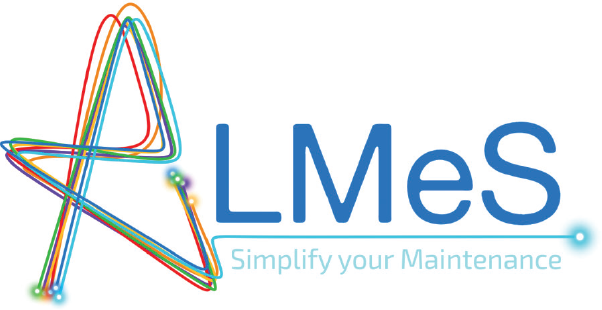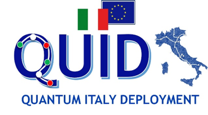QUID
Quantum Italy Deployment
| EU DIGITAL Programme (EU Secure Quantum Communication Infrastructure) (Period 2023-2025) | |||||||||
QUID is a research project funded in the context of the Digital Europe Program. QUID proposes to start the deployment of the Quantum Communication Infrastructure (QCI) in Italy. QUID will deploy systems and networks on the national territory to test quantum communication technologies, in particular for the quantum distribution of cryptographic keys (QKD), with attention to integrating them with existing communications. QUID will employ several nodes in Metropolitan Area Networks based on Discrete Variable QKD, connected by a fibre backbone, connecting also sites relevant for interconnection with the space segment of the European QCI. QUID will promote activities towards improving QKD features, in particular high-rate, use of innovative fibres, and the use of free-space QKD, to be implemented for mobility and where fibre is not present. The QUID partenrs will provide their expertise in fiber procurement and deployment readiness for QKD, with and without data traffic. The QUID consortium includes: Politecnico di Milano, Università degli Studi dell’Aquila, Università La Sapienza, Università degli studi di Napoli Federico II, Università degli studi di Padova, Università degli studi di Trieste, CNR, ASI, Cohaerentia,Thales Alenia Space – Italia, QTI, Leonardo, ThinkQuantum, TIM, Telsy, Telespazio, TOP-IX.
 SENSING NET
SENSING NET
Introducing SENSING capabilities in deployed TLC fiber NETworks
| PNRR NextGeneration EU – “Telecommunications of the Future” (PE00000001 – program “RESTART”) – Spoke 1 focused project F11 (period: 2023-2025) | |||||||||
SENSING NET project targets to enhance the value of the already deployed optical fiber TLC infrastructure by introducing fiber sensing technologies to explore novel potential applications, assuring additional revenues for networking-service providers, fiber network owners and operators. SENSING NET will explore proper TLC-compatible sensing strategies to achieve real-time pervasive monitoring of mechanical, thermal, electrical and seismic phenomena. The sensing solutions developed and experimented in SENSING NET will provide not only the control and supervision of the TLC infrastructure integrity, but also distributed diagnostics and surveillance in urban and regional scenarios.
SENSING NET achievements will support institutional decision makers in fields ranging from the civilian to the environmental protection, for the prompt detection of structural faults, and hazards.
 RIGOLETTO
RIGOLETTO
Green autonomic optical networks, systems and integrated devices
| PNRR NextGeneration EU – “Telecommunications of the Future” (PE00000001 – program “RESTART”) – Spoke 1 structured project S4 (period: 2023-2025) | |||||||||
RIGOLETTO goals are: design an energy-efficient optical network, which reduces electronic hops and deploys novel photonic integrated devices exposing control interfaces; design of novel optically integrated devices for switching, transmission and networks; design and validation of an innovative data plane of an optical transport infrastructure supporting capacity enhancement via multiple bands, spatial division multiplexing, optical wireless access and security through QKD; development of a monitoring/telemetry platform covering the optical data plane transmission and switching; build a framework for an AI-assisted autonomic network supporting zero-touch real-time operations. In RIGOLETTO, the PoliCom group is involved in the research activities of WP4 “Physical-layer-aware open and green optical networks” and of WP6 “Demonstrators and prototypes of the future green sustainable optical devices, systems and networks”.
Q-SECURE NET
Quantum-Secure communication network
| EIT Digital 2020 Activity | |||||||||
Q-Secure Net will provide a cost effective and flexible solution for unconditionally secure communication services based on Quantum Key Distribution (QKD) on current metropolitan fiber-optic networks. A novel blockchain application based on the secure network platform will be also implemented.
FIRST
Fiber Infrastructure for Research on Space-Division Multiplexed Transmission
| MIUR Project PRIN 2017 (period: 2020-2024) | ||||||||
Communication technologies are challenged by a global demand for data traffic that grows exponentially, fueled by more and more bandwidth-hungry applications that rely on the internet. Space-division multiplexing (SDM) on few-mode fibers (FMFs) and multi-core fibers (MCFs) is a revolutionary approach that has been considered in recent years to prevent the capacity crunch of the optical transport network – the back-bone of the global telecom infrastructure – and many lab demonstrations of SDM have been on the spotlight of the major conferences in the field. This project has the ambition of demonstrating the first deployed SDM system, bringing SDM from lab experiments to field trials. This revolutionary transition is enabled by a synergy with project INCIPICT, which makes available to FIRST a pioneer SDM fiber-optic infrastructure in L’Aquila city. By gathering together the most prominent Italian research groups in the area of optical communications, FIRST targets demonstrating the effectiveness and viability of SDM in FMFs and MCFs, as well as its superior performance in the comparison with standard single-mode fiber technology that is used today. The results of FIRST will provide the ultimate demonstration of SDM transmission, well out of reach of lab experiments relying on spooled fibers.
 PASSION
PASSION
Photonic technologies for progrAmmable transmission and switching modular systems based on Scalable Spectrum/space aggregation for future agIle high capacity metrO Networks
| EU Horizon2020 Project (RIA ICT-30 call PHOTONICS KET) (period: 2018-2021) | ||||||||
The PASSION project will develop new photonic technologies for supporting agile metro networks, enabling capacities of Tb/ s per channel, 100 Tb/s per link and Pb/s per node over increased transport distances. A new metro network infrastructure is envisioned, fitting the network operator roadmap and targeting at least a tenfold reduction in components energy consumption and footprint. These breakthroughs are achieved by developing all the essential photonic building blocks. On the transmitter side a novel 3D stacked modular design will be developed combining a silicon photonics (SiPh) circuit layer with directly modulated high-bandwidth 1550nm VCSELs light sources. At the receiver side we will develop novel InP based coherent receiver arrays which handle polarization on chip making polarization handling off chip unnecessary. Finally, we will develop a compact and cost-effective switching concept which can support the Pb/s capacities generated by the transceiver modules, using a combination of InP and SiPh PICs. Increased system flexibility and modularity is obtained by sliceable bandwidth/bitrate variable transceivers. The resulting solution will offer scalability, programmability and re-configurability using agile aggregation in spectrum, polarization and space dimensions.
PASSION will contribute to reinforce European industrial technological leadership in high-capacity photonic devices and sub-systems, addressing the growing market of metro network scenarios, improving business opportunities in Europe.
Politecnico di Milano is the project coordinator and the PASSION consortium includes other universities, research centres, device manufacturers, a supplier of communication equipment and a network operator, addressing the entire value chain.
PASSION has a strong industrial commitment, demonstrated by the presence of two large enterprises and four SMEs, which will identify the path to industrial exploitation, standardization and commercialization, while universities and research centres will support the scientific dissemination.
The project is an initiative of the Photonics Public Private Partnership and is funded by EU through the H2020 RIA ICT-30 call PHOTONICS KET.
Website: http://www.passion-project.eu/
 ALMeS
ALMeS
ALM–enabled Smart Maintenance
 |
founded by EIT Digital (period: 2016-2017) |
ALMeS is the building block of digital maintenance. The kit consists of add-on multiple sensors, connectivity and applications optimizing machinery performances, lowering the investment barrier for smart maintenance.
Nowadays, the maintenance of machinery is performed mainly condition-based or on run-to-failure due to missing real-time data as sensorization of machinery is still expensive and difficult to deploy.
The ALMeS project provides a package of Add-on, Low cost, Multi-purpose (ALM) fiber optic sensors and applications, that includes cloud-based analytics for real-time alerts and mid-term predictions. The kit is based on inexpensive microcontrollers and machine-learning software.
In decreasing the investment costs for smart maintenance, the project is expected to have a strong impact in many industrial sectors
with medium-to-high level of process automation.
NGCTR DIGIFuel
Distribution and Gauging Interconnected Fuel System for the Next Generation Civil Tilt Rotor
| EU Horizon2020 Project (CleanSky Call 02) (period: 2016-2021) |
Secondo Mona, an established Italian aerospace SME with over 100 years of contributions to the aerospace industry, proposes to design, develop, test and qualify a high reliability integrated Fuel Gauging and Distribution System (DIGIFuel), providing active CG management, for the NGCTR. Politecnico di Milano will collaborate on new technology developments, especially about power and data transmission over optical fibers.
The envisaged, uncommon, proposed system architecture is based on the presence of a “filtered” collector tank close to each engine and modular transfer tanks distributed in the airframe: the digital acquisition and control, by NGCTR computers, of pioneering smart transfer pumps and innovative fiber-optics based level sensors, will offer unconstrained possibility to manage NGCTR balancing while ensuring filling of collector tanks through a novel filtering and sensing sub-system. The development will thus include a purposely designed 270 VDC pump package with microprocessor based electronics, groundbreaking discrete and continuous level sensors with only optical cables inside fuel tanks, as well as validation of water and dirt filters and sensors.
Secondo Mona, applying the most advanced Program and Risk Management disciplines, already in use for any new development program, will guarantee adequate control on the activities from the initial trade off studies up to detail design and manufacturing of all equipment and relevant qualification, to ensure clearance for flight to the system.
The newly developed products will enhance the Secondo Mona proven fuel systems design capabilities, ensuring uncompromised and interconnected solutions to the customers, for the advantage of reliability, safety and maintenance. The project will also consolidate the long lasting collaboration with Politecnico di Milano, helping to disseminate the results, and will further create value within the area of the Lombardy Aerospace Cluster.
 ADVENT
ADVENT
ADvanced Virtualization for Enabling Network Technology and applications
| Research Project funded by Regione Lombardia – Accordo per la competitività 2014 (period: 2015-2016) |
The research activity will be related to the Project ADVENT (LOMBARDIA REGION) focused to the optimization of the data center architecture and design to reduce the complexity exploiting the capabilities of fiber optic communications. The program object of the research includes the study and the simulation of optical fiber systems for intra datacenter communications, which will evolve from the protocols now dominant in telecom environment (Ethernet) to one of the predominant electric interface (PCIe). The exploitation of optical fiber can allow the connection of PCIe interface with very high capacity even remotely, giving the PCIe solution the capability to share I/O devices and the ability of high speed communications between the CPUs.

FF-PHOTON
Functional Thin-Film Ferroelectric Materials for CMOS Compatible Photonics
| EU FP7 Project CONCERT JAPAN – Connecting and Coordinating European Research and Technology Development with Japan (period: 2014-2016) |
Ferroelectric materials have been extensively explored for various practical applications such as nonvolatile memories and capacitors. Of particular interest is the strong electro-optic effect in many ferroelectrics that is absent in silicon. Recently, thin-film ferroelectric materials have attracted increasing attention as advanced functional photonic materials in CMOS compatible silicon photonics. While proof-of-concept demonstrations of functional ferroelectric layers have already been given, neither the manufacturing nor characterization can cope with the challenges posed by a future chip-scale photonic fabrication.
In this interdisciplinary project, we will investigate the light-matter interaction of epi-grown thin-film ferroelectric materials and develop the related manufacturing and characterization technologies. As an outcome of the project we envision a deep and comprehensive understanding of the photo-responsive process of ferroelectric thin-films and the establishement of a platform for CMOS compatible ferroelectric thin-films and enabled innovative optical devices. Swiss, Japanese and Italian project partners will work on the device design and fabrication, film integration, material and device characterization, respectively, with mutual collaborations.
Website: https://www.ffphoton.ethz.ch/
 ROAD NGN
ROAD NGN
Rete Ottica di Accesso e Divisione di frequenza e/o di lunghezza d’onda per soluzioni Next Generation Network
| MIUR Project PRIN2010-2011 (period: 2013-2016) |
The project ROAD-NGN aims at the study, design and characterization of novel Orthogonal Frequency Division Multiplexing (OFDM)- and wavelength division multiplexing (WDM)-based optical access architectures which enable the unbundling of the local loop (ULL), with test-bed demonstrations. Different methods of assigning OFDM subcarriers and WDM wavelengths are evaluated, as well as procedures for a possible change of network operator; we investigate techniques to convey broadcast and multicast services, the transmission of High Definition (HD) television signals, the migration from existing copper-based solutions, the energy consumption for green solutions. The regulations established by the Italian Communications Authority (AGCOM) are taken into account, in terms of architectures, services and ways of granting unbundled access.
The optimal sharing of the existing infrastructures and an efficient access management will allow the deployment of a national NGAN compatible with the Digital Agenda, with a much lower cost than it has been estimated nowadays.
The ROAD-NGN project also includes, as a case-study, the new optical access network of the historical downtown L’Aquila, which still is to be rebuilt after the destructive earthquake of April 6th 2009. We hope that this reconstruction will be an opportunity to experiment new infrastructures for a smart and human scale town.
Website: http://www.roadngn.uniroma3.it/index.html
ERMES
Embedded Resonant and ModulablE Self-Tuning Laser Cavity for Next Generation Access Network Transmitter
| EU FP7-ICT Project STREP (period: 2011-2014) |
For the Next Generation Access Network (NGAN) wavelength division multiplexed passive optical networks(WDM PON) appear a promising and suitable solution offering almost unlimited bandwidth similarly to point-to-point links, while allowing the advantages of fibre sharing.
It is widely recognized that WDM PON deployment requires colourless Optical Network Unit (ONU) transmitters, so that each user has the same transmitter. Up to now these characteristics has been unsatisfactorily obtained either with a costly tunable transmitter or by exploiting external seeding sources.
Website: http://ermes-project.eu/

BACKOP
Backplane Ottico per Apparati ICT di Alta Capacità
| MIUR Project Programma Operativo Nazionale “Ricerca e Competitività 2007-2013” Regioni Convergenza (period: 2011-2014) |
As ‘backplane’ is usually meant as the inter-connection plate, made of composite material, on which the various subsystems of a telecommunication system are merged. The BACKOP project is aimed at verifying the industrial feasibility of a backplane for communication networks that are able to support a large variety of tranmission protocol technologies, from the TDMto Ethernet, MPLS or IP. On an optical backplane, instead, the interconnection signals between different subsystems are sent through optical fibers, that replace the traditional metallic tracks. Indeed, the fiber-optic transmission avoids em interferences between adjacent channels while it reduces the energy required to transmit the information over the connection length. Such features envisage future backplanes that rely on an all-optical technology that will increase the transmission volume and decrease the absorbed power, for a fixed length and cost. Therefore, we plan to devise and develop some optical backplane prototype, using standard production technologies, which can also be implemented for large-scale production. The project will provide information on the actual feasibility of an industrial-grade backplane, also in terms of performance. The optical connections between backplanes and internal boards will be ensured by innovative connectors, which will be designed and fabricated within the project activity in order to optimize their compatibility with existing standards. The prototypes will be validated and analyzed in terms of reliability for industrial use.
Website: http://www.ino.it/en/
Other projects:
- Research Project, funded by Ministero dello Sviluppo Economico: “DIALTO – Link di trasporto ottico per apparati digitali” (period: 2007-2008)
- Research Project FIRB 2003: “Composti molecolari e materiali ibridi nanostrutturati con proprietà ottiche risonanti e non risonanti per dispositivi fotonici” (period: 2005-2008)
- Research Project funded by FONDAZIONE CARIPLO – Bando Ricerca Applicata 2004: “Sviluppo di dispositivi ottici basati su materiali nanostrutturati autoaggreganti prodotti per via elettrochimica” (period: 2006-2007).
- Research Project funded by Fondo Sociale Europeo – Misura D4 – Regione Lombardia: “Sensori a fibra ottica per la gestione di reti elettriche” (period: 2004-2005)
- MIUR Project PRIN2001: “Trasmissione su sistemi OTDM ad elevatissimo bit-rate” (period: 2001-2003)
- MURST Project PRIN1999: “Sistemi e tecniche per OTDM ad altissimo bit-rate” (period: 1999-2000)
- EU FP6 Project IP: “NOBEL – Next generation Optical network for Broadband European Leadership” (period: 2004-2005) as partner of Pirelli Labs S.p.A
- EU FP6 Project IP: “NOBEL2 – Next generation Optical network for Broadband European Leadership phase 2” (period: 2006-2007)


